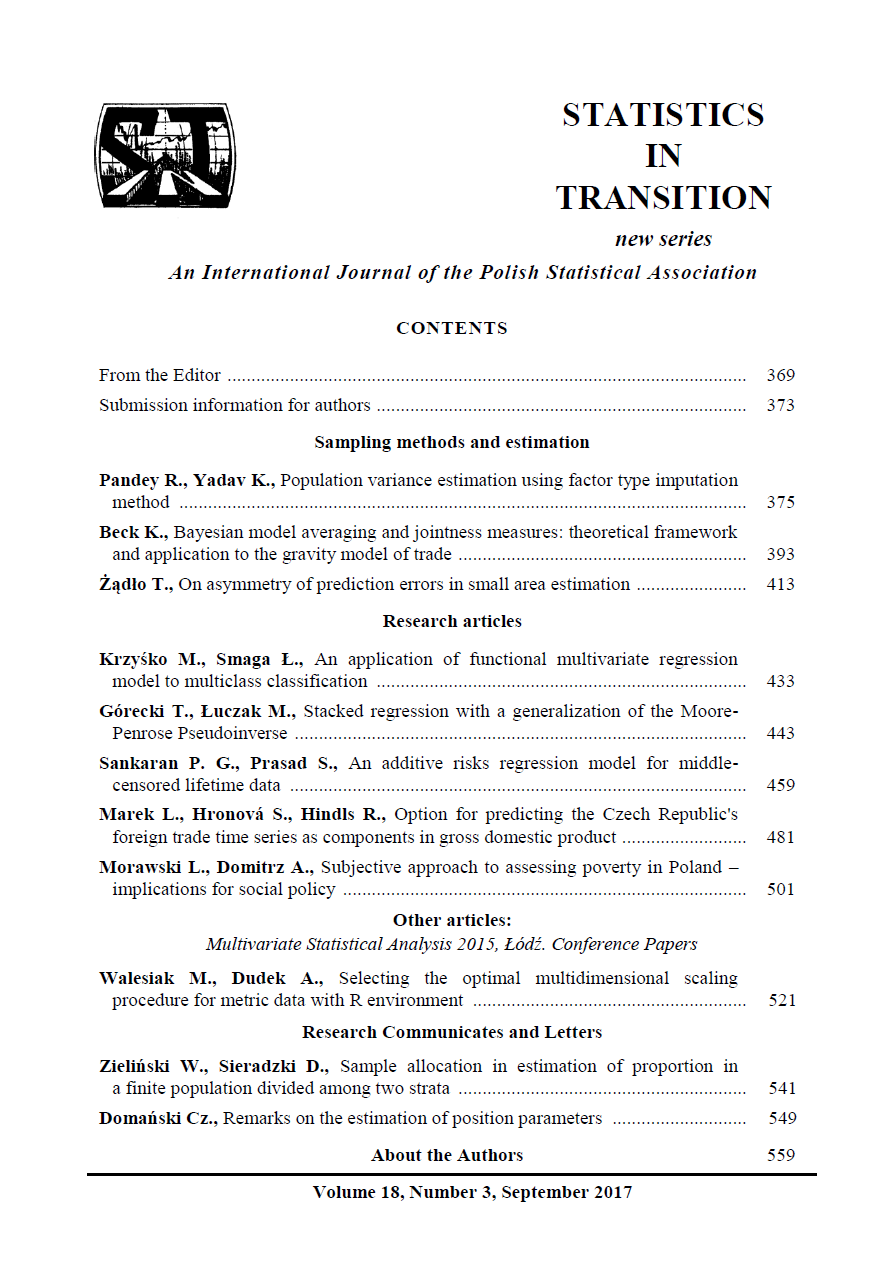ARTICLE
ABSTRACT
The poverty rates based on the OECD scales are frequently used in public debate. In this scale, large families are usually identified as those most in need of financial support. Poland is an interesting case for applying an alternative, subjective approach to calculating equivalent scales, as Poland has a large mean size for households, and is dependent on means-testing in social policymaking. The overall poverty rates for the two approaches are not distinctly different but they lead to significantly different distributions of poverty, as different types of households are considered in line with the result in Bishop et al. (2014) for the eurozone countries. The subjective approach suggests that one-person households, not large families, should be considered most at risk of material poverty. Futhermore, the relative positions of households in the income distributions also differ considerably. As a consequence, the current shape of social policy in Poland may need to be reconsidered in order to distribute public transfers more accurately.
KEYWORDS
ubjective poverty, household equivalence scale, social policy.
REFERENCES
ATKINSON, A. B., (2017). Nierówność szans: co da się zrobić, Wydawnictwo Krytyki Politycznej.
BINDER, M., COAD, A., (2011). From Average Joe’s happiness to Miserable Jane and Cheerful John: using quantile regression to analyze the full subjective well-being distribution, Journal of Economic Behavior &Organization, 79, 3, pp. 275–290.
BISHOP, J. A., GRODNER, A., LIU, H., AHAMDANECH-ZARCO, I., (2014).Subjective Poverty Equivalence Scales for Euro Zone Countries. The Journal of Economic Inequality, 12 (2), pp. 265–278.
BOLLINGER, C., NICOLETTI, C., PUDNEY, S., (2012). Two can live as cheaply as one…but three's a crowd, ISER Working Paper Series10/2012, Institute for Social and Economic Research, University of Essex.
BLUNDELL, R., LEWBEL, A., (1991). The Information Content of Equivalence Scales, Journal of Econometrics, 50, 3, pp. 49–68.
DE REE, J., ALESSIEZ, R., PRADHANX, M., (2013). The price and utility dependence of equivalence scales: Evidence from Indonesia, Journal of Public Economics, 97, pp. 272–281.
DE VOS, K., GARNER, T., (1991). An Evaluation of Subjective Poverty Definitions: Comparing Results from the U.S. and the Netherlands, Review of Income & Wealth, 37, 3, pp. 267–285.
CHIAPPORI, P.-A., (2016). Equivalence Versus Indifference Scales, Economic Journal, 126, pp. 523–545.
DUDEK, H., (2009). Statystyczna analiza subiektywnej oceny dochodów gospodarstw domowych rolników, Roczniki Nauku Rolniczych, Seria G, 96 (4), Szkoła Główna Gospodarstwa Wiejskiego, Warszawa.
DUDEK, H., (2012). Subiektywne skale ekwiwalentności - Analiza na podstawie danych o satysfakcji z osiąganych dochodów, Research Papers of Wrocław University of Economics Series 242, pp. 153–162.
DUDEK, H., LANDMESSER, J., (2012). Income satisfaction and relative deprivation, Statistics in Transition, 13, 2, pp. 321–334.
FERRER-I-CARBONELL, A., FRIJTERS, P., (2002). How important is Methodology for the Estimates of the Determinants of Happiness? Discussion Paper TI 2002-024/3, Tinbergen Institute, University of Amsterdam.
GUS, (2011). Metodologia badania budżetów gospodarstw domowych, GUS, Warszawa.
GUS, (2011a). Ubóstwo w Polsce w 2011 r. (na podstawie badań budżetów gospodarstw domowych, GUS), Warszawa.
IACOVOU, M., SKEW, A., (2010). Household structure in the EU, Luxemburg: European Commission.
KALBARCZYK, M., MIŚTA, R., MORAWSKI, L., Subjective equivalence scales – cross-country and time differences, International Journal of Social Economics, forthcoming
KAPTEYN, A., VAN HERWAARDEN, F., (1981). Empirical comparison of the shape of welfare functions, European Economic Review 15, 3, pp. 261–286.
KAPTEYN, A., VAN PRAAG, B., (1976). A new approach to the construction of family equivalence scales, European Economic Review, 7, 4, pp. 313–335.
LEWBEL, A., PENDAKUR, K., (2008). Equivalnence scales. In S. Durlauf and L. Blume (ed.), The New Palgrave Dictionary of Economics, Palgrave Macmillan.
PANEK, T., CZAPIŃSKI, J., (2015). Wykluczenie społeczne, Contemporary Economics, Vol. 9, 4, pp. 396–432.
PODGÓRSKI, J., (1990). Zastosowanie metody "Leyden Poverty Line" w warunkach Polski, Wiadomości Statystyczne, 11, pp. 5–9.
PODGÓRSKI, J., (1991). Subiektywne linie ubóstwa - nowe wyniki, Wiadomości Statystyczne, 11, pp. 6–12.
PODGÓRSKI, J., (1994). Metody wyznaczania subiektywnych linii ubóstwa. Wiadomości Statystyczne, 12, pp. 12–19.
POLLAK, R., WALES, T., (1979). Welfare comparisons and equivalence scales, American Economic Review, 69, 2, pp. 216–221.
SCHOKKAERT, E., VAN OOTEGEMY, L., VERHOF, E., (2011). Preferences and Subjective Satisfaction: Measuring Well-being on the Job for Policy Evaluation, CESifo Economic Studies, 57, 4, pp. 683–714.
SEIDEL, B., (1994). How sensible is the Leyden individual welfare function of income?, European Economic Review, 38, 8, pp. 1633–1659.
STEVENSON, B., WOLFERS, J., (2008). Economic Growth and Subjective Well-Being: Reassessing the Easterlin Paradox, Brookings Papers on Economic Activity ( Economic Studies Program), 39, 1, pp. 1–102.
SZULC, A., (2014). Empirical versus policy equivalence scales: matching estimation, Bank i Kredyt, 45, 1, pp. 37–52
VAN DEN BOSCH, K., (2002). Identifying the Poor: Using subjective and consensual measures, Ashgate Publishing Limited.
VAN PRAAG, B., (1971). The welfare function of income in Belgium: An empirical investigation, European Economic Review, 11, 3, pp. 337–369.
VAN PRAAG, B., FERRER-I-CARBONELL, A., (2004). Happiness Quantified, Oxford: Oxford University Press.
VAN PRAAG, B., KAPTEYN, A., (1994). How sensible is the Leyden individual welfare function of income? A Reply, European Economic Review 38, 9, pp. 1817–1825.
VAN PRAAG, B., VAN DER SAR, N., (1988). Household Cost Functions and Equivalance Scales, Journal of Human Resources, 23, 2, pp. 193–210.
VEENHOVEN, R., (2002). Why Social Policy Needs Subjective Indicators? Social Indicators Research, 58, 1, pp. 33–45
